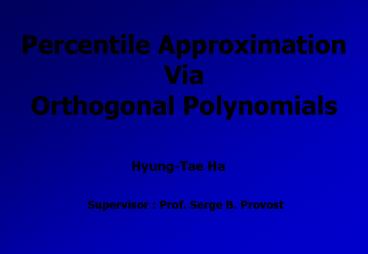Percentile Approximation - PowerPoint PPT Presentation
Title:
Percentile Approximation
Description:
We are considering the problem of approximating a density function from ... Suppose that w(x) is a nonnegative real function of a real variable x. Let (a, b) ... – PowerPoint PPT presentation
Number of Views:27
Avg rating:3.0/5.0
Title: Percentile Approximation
1
Percentile Approximation Via Orthogonal
Polynomials
Hyung-Tae Ha
Supervisor Prof. Serge B. Provost
2
O U T L I N E
3
Introduction
4
Research Domain Density Approximation
Focus Continuous distributions
Unknown
Density Approximant
Density Estimate
Theoretical Moments
Xi Sample
We are considering the problem of
approximating a density function from the
theoretical moments (or cumulants) of a
given distribution (for example, that of the
sphericity test statistic)
5
Moment Problem
1. While it is usually possible to determine the
moments of various random quantities used in
statistical inference, their exact density
functions are often times analytically
intractable or difficult to obtain in closed
forms. 2. Suppose a density function admits
moments of all orders. A
given moment sequence doesnt define a density
function uniquely in general. But it does
when the random variable is on compact
support. 3. The sufficient condition for
uniqueness is that 4. The moments can be
obtained from the derivatives of its moment
generating function (MGF) or by making use of the
recursive relationship to express moments in
terms of cumulants.
is absolutely convergent for some t gt 0.
6
Literature Review
Pearson Curve
Saddlepoint
Approximating density function using a few moments
Approximating density function using cumulant
generating function
Concept
- Adequate Approximation
- A Variety of Applications
- Unimodal
- Difficult to implement
- Tail Approximation is good.
- A Variety of Applications
- Unimodal
- Using up to 4 moments
Characteristic
Solomon and Stephens (1978), Approximations to
density functions using Pearson curves, JASA
Daniels, H.E. (1954), Saddlepoint
Approximations in Statistics, Annals of
Mathematical Statistics
Paper
7
Literature Review
Cornish-Fisher Expansion
Orthogonal Series Expansion
Approximating the density function of noncentral
Chi-squared and F random variables
Based on cumulants of a distribution
Concept
1. Expressible in terms of Hermite
Polynomial 2. Gram-Charlier series 3. Edgeworths
Expansion
- Laguerre series forms
Characteristic
Cornish and Fisher (1938) Fisher and Cornish
(1960) Hill and Davis (1968)
Tiku (1965)
Papers
8
Orthogonal Polynomial Approximants
9
Brief Review of Orthogonal Polynomials
Suppose that w(x) is a nonnegative real function
of a real variable x. Let (a, b) be a fixed
interval on the x-axis and suppose further that,
for n0,1,, the integral
exists and that the integral
is positive.
10
Then, there exists a sequence of polynomials
p0(x), p1(x),, pn(x), that is uniquely
determined by the following conditions
1) is a
polynomial of degree n and the coefficient of xn
in this polynomial is positive.
2) The polynomials p0(x), p1(x),, pn(x), are
orthogonal w.r.t. the weight function w(x) if
We say that the polynomials pn (x) constitute a
system of orthogonal polynomials on the interval
(a, b) with the weight function w(x) and
orthogonal factor . If ,
pn (x) is called orthonormal polynomials.
11
Orthogonal Polynomial Approximation
Approximant
Base Density
Orthogonal Polynomial
Coefficients
12
Jacobi Polynomials
Base Density
Jacobi Polynomial
13
Jacobi Polynomial Approximant
X (-1, 1)
Y (a, b)
Transformation
Approximant
14
Jacobi Polynomial Approximant
Distribution Approximant
where
15
Laguerre Polynomials
Base Density
Laguerre Polynomial
16
Laguerre Polynomial Approximant
Y
X
Transformation
Given the moments of Y
Approximant
17
Application to Statistics on Compact Support
18
The Lvc Test Statistic
Hypothesis All the variances and
covariances are equal.
Test Statistic by Wilks (1946)
where
Moments
19
In the case of P3, N11
4th degree Jacobi Polynomial Density Approximant
Wilks (1946) determined that 1st and 5th
percentiles are 0.1682 and 0.2802, respectively.
F4 0.16820.0100071 F4 0.28020.050019
20
The V test statistic
Hypothesis Equality of variances in
independent normal populations
Test Statistic
Moments
21
p5, N12
4th degree Jacobi Polynomial Density Approximant
Mathai (1979) determined that 1st and 5th
percentiles are 0.27336 and 0.38595,
respectively.
F4 0.273360.00999801 F4 0.385950.0049923
22
Application to Statistics on the Positive Half
Line
23
Test statistic for a single covariance matrix
Hypothesis Covariance matrix of multivariate
normal population is
equal to a given matrix
Test Statistic
MGF
24
p5 and N10
4th degree Laguerre Polynomial Density
Approximant
Korin (1968) determined that 95st and 99th
percentiles are 31.40 and 38.60,
respectively.
F4 31.400.950368 F4 0.385950.990075
25
Generalized Test of Homoscedasticity
Hypothesis The constancy of variance and
covariance in k sets of
p-variate normal samples
Test Statistic
MGF
26
p2, k5 and N45
27
Computation and Mathematica Codes
28
Computational consideration
- The symbolic computational package Mathematic
- was used for evaluating the approximants
and - plotting the graphs.
- 2. The code is short and simple.
- The formula will be easier to program when
orthogonal - polynomials are built-in functions in the
computing packages.
29
Mathematica Code Jacobi Polynomial Approximant
30
Mathematica Code Laguerre Polynomial
Approximant
31
Conclusion
32
Concluding Remarks
- 1. The proposed density approximation
methodology yields - remarkably accurate percentage points while
being relatively - easy to program.
- The proposed approximants can also accommodate a
large - number of moments, if need be.
- For a vast array of statistics that are not
widely utilized, - statistical tables, when at all available
or accessible, are likely - to be incomplete the proposed methodology
could then - prove particularly helpful in evaluating
certain p-values. - When a table is needed for a specific combination
of parameters, - the proposed methodology could readily
generate it.

